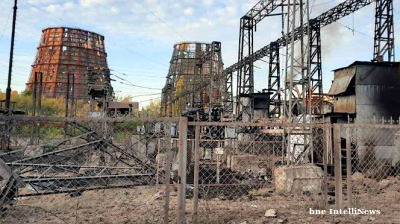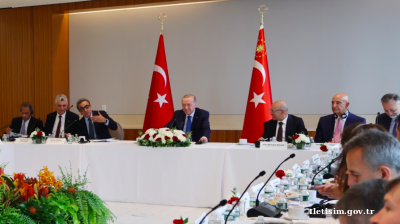Ukraine's government budget has a roughly $5bn a month short fall is already tapping its international reserves to finance the gap and fund the war, but Kyiv could run into trouble if it doesn't get more help soon.
Wars are very expensive and very hard to finance. Ukraine has been thrown into a conflict with a much larger and better funded adversary and it is struggling to raise enough money to continue its heroic resistance against the Russian invader. The country is currently relying on the central bank for the lion's share of government funding but international donors play a key role and if they don’t pay attention to the country’s fiscal needs Ukraine faces the danger of a balance of payments crisis, said Institute of International Finance (IIF) in a recent note.
Kyiv is burning just over $8bn a month on military expenses, but in addition has to pay teachers, firemen and doctors their wages, fund the running of government and service its debt in order to prevent economic collapse.
As tax revenues have collapsed to 20% of their previous level the government is short of about $5bn a month to cover its total expenditure.
The international community has been offering financial aid. The US said on June 15 that it will send $1.5bn a month to shore up the government’s finances. Altogether Kyiv has received a total of $6.8bn in assistance by the start of June. But it's not enough: the fiscal gap between income and outgoings reached $4.5bn in May alone.
More help is on the way. The international community has committed an additional $23bn until the end of 2022 but, IIF said in a note, “the money may not come quickly enough.”
With the international capital markets closed the government has nowhere else to go and has been tapping the National Bank of Ukraine (NBU) reserves to finance the war and whatever it can get from issuing war bonds.
Ukraine went into the war in a relative healthy financial state with $28.1bn in reserves, equivalent to five months of import cover, a comfortable level, and a modest 50% debt-to-GDP ratio. But since then those reserves are under pressure and slid to $25.1bn in May.
“The cash hryvnia market, as well as NBU reserves, have already come under pressure and the central bank was forced to more than double the policy rate from 10% to 25% on June 2 – the first rate decision since the beginning of the war,” Elina Ribakova, deputy chief economists at IIF said in a note following a recent trip to Kyiv.
Ukraine’s economy has been hard hit by the military conflict but is now gradually beginning to recover and find a new equilibrium, says Ribakova. As a result, both the NBU and Ministry of Finance have suggested a gradual normalization of monetary and fiscal policies following a period of extraordinary stabilisation measures. The NBU has restarted regularly scheduled policy meetings – having suspended them after the invasion – and is considering moving away from the temporarily-fixed hryvnia exchange rate, imposed to keep the currency stable during the initial shock of the start of the war.
At the same time, MinFin has recently suggested to the Rada that it is time to return to the pre-war tax regime by removing exemptions. Immediately after the fighting started many taxes were simply suspended and others simplified in an effort to keep some revenues flowing into the state coffers. But with cafés, shops and restaurants reopening in Kyiv and other central and western cities, the government is trying to go back to business as usual – including making people pay their taxes.
“[The exemptions] have not only weighed on revenues but also led to a meaningful pickup in non-essential imports and, in turn, driven the goods balance back into negative territory in April as exports remain constrained by logistical bottlenecks – in particular as it relates to agricultural products – and substantial damage to physical infrastructure, including in the metals and mining sector,” Ribakova said.
The biggest change in the government’s financial position was the emergency rate hike at the start of June. Like everywhere else, inflation has been soaring and the currency is weak, forcing the regulator to intervene in the market and use up valuable reserves. Countries across the world, but especially developing markets, are facing stagnation and central banks around the world need to hike rates aggressive to bring inflation under control.
The NBU was the first central bank to hike rates in early 2021 when post-Covid inflation rates began rising everywhere, and it has again taken dramatic action this time too.
“While the current account remains in surplus, pressure on reserves has been stemming from the financial account – including from an increase in trade credits which could stem from capital flight or issues with customs data,” Ribakova said. “With the real policy rate in deeply-negative territory and relatively loose capital controls, outflows from hryvnia assets inevitably accelerated.”
Currently the NBU is the biggest and most important source of funding for the budget. At the start of the war most of the ordinary rules that govern the regulator’s actions were suspended, including inflation targeting and a rule that prevents it from directly transferring money to the government for no reason. Now the NBU is the biggest contributor to the budget, accounting for UAH120bn during the first 100 days, or 42% of all new funding, according to IIF calculations.
“As a result, the central bank’s share of holdings of UAH-denominated government securities has risen from 34% to above 45%. Additionally, significant monetary financing of the budget, together with supply shocks, has led to an acceleration in headline inflation to 18%. The NBU’s decisive rate hike this month is sending an important signal to the market but would be even more impactful should the Ministry of Finance also adjust the interest rates offered for its bonds. Otherwise the monetary policy transmission mechanism may be hindered,” says Ribakova.
Still, as an unsettled peace returns to much of the country the government has more work ahead of it to get the wheels of commerce turning again. The Ministry of Finance is contemplating dropping wavers on excise and import taxes and return to the pre-war tax regime. This would bring in additional revenue but also reduce incentives for non-essential imports such as cars, consumer durable goods and luxury items, thereby taking pressure off the current account.
“While we think that the NBU’s monetary policy normalisation is encouraging, we remain concerned that the risk of fiscal and balance of payments crises will increase as the war drags on,” says Ribakova. “To avoid such a scenario, a combination of faster disbursement of international assistance and additional policy measures is needed.”
Despite the “Stand with Ukraine” rhetoric, the West has been slow and meagre with its financial support. Another $23bn has recently been pledged for financial support of the budget through to the end of the year but will be paid out at a rate of just above $3bn per month – not enough to close the expected fiscal gap of $4-5bn a month (of which $2bn a military spending alone), say Ribakova.
Slightly less pressing but also a headache is that Ukraine is keen to maintain its credit worthiness and service its debts, which remain relatively modest.
Minister of Finance Serhiy Marchenko assured investors that Ukraine will be able to service its foreign debt this year in an interview in May. The state paid $200mn in May, and a similar payment must be made in June-August.
"In September, Ukraine has to fulfil its obligations and pay $900mn for Eurobonds. We are working on it now, but I would like to say that we will continue to service our debt obligations," the finance minister stated.
Market external debt due at year-end was pretty light at a few billion dollars, but the war has decimated public finances. Analysts believe that Kyiv has enough money to meet its obligations up until the autumn, but the market is anticipating some sort of restructuring deal later in the year, similar to that cut in 2015 by then Finance Minister Natalie Jaresko that delayed payments for five years and introduced GDP warrants as compensation with extremely generous terms. So far, the authorities have been adamant about avoiding a restructuring.
That makes Western aid to the government key to managing its needs and obligations. The NBU would likely be able to pause with rate hikes and begin to gradually liberalise the FX market, as it said it wants to on April 18.
A return to a fully flexible exchange rate will probably be delayed for several more months, says IIF, and will be partly dependent on the level of financial support that Ukraine receives from its international partners.
“In the absence of more financial assistance, tighter capital controls could become necessary. At the same time, the NBU also needs to take into account refugees’ spending needs abroad. Should the current drain on reserves from imports and capital outflows subside, central bank reserves of $25.1bn (as of end-May) should allow meeting upcoming FX-denominated repayments,” says Ribakova. “However, the situation remains fluid and a full-fledged fiscal and balance of payments crisis is a distinct possibility, and Ukraine’s international partners should not make the mistake [of focusing] on rebuilding efforts alone while the immediate implications of the war continue to present an urgent challenge.”




Features

Ambition, access and acceleration – Uzbekistan’s Startup Garage opens free academy for entrepreneurship
Aim is to train 50,000 young founders by 2030.

Ukraine’s growing energy crisis promises a cold and dark winter
Since the summer, Kyiv has changed tactics. Given the almost complete failure of Western oil sanctions to curb Russian oil exports, it has been targeting Russian oil refineries. The Kremlin has struck back, targeting Ukraine's power system.

Russia, China sign off on Northern Route shipping deal to slash global freight times
Russia and China have signed a landmark agreement to develop and commercialise the Northern Sea Route (NSR), after Beijing tested the route last month, that could slash Europe-Asia cargo transit times and challenge the primacy of the Suez Canal.

Sri Lanka’s economic escape
Sri Lanka’s recovery over the past year reads like a narrow escape rendered into a cautious, albeit unfinished success story.



